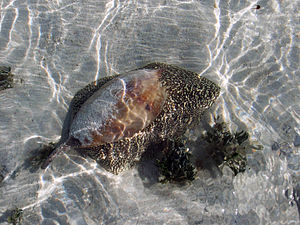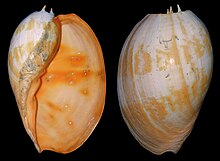Diadem roller screw
| Diadem roller screw | ||||||||||||
|---|---|---|---|---|---|---|---|---|---|---|---|---|

Melo amphora in situ |
||||||||||||
| Systematics | ||||||||||||
|
||||||||||||
| Scientific name | ||||||||||||
| Melo amphora | ||||||||||||
| ( Lightfoot , 1786) |
The diadem snail ( Melo amphora ) is a very large snail from the family of the roller snail (genus Melo ), which is widespread in the central Indo-Pacific . It feeds on snails and clams .
features
The very large, round, egg-shaped snail shell of Melo amphora , which in adult snails reaches a length of about 30 cm, sometimes even more than 50 cm, has a very short, blunt thread that barely protrudes from the huge, inflated body, and one smooth, dome-shaped apex. The edged whorls are covered at the top with protruding, furrowed spines, which are no longer formed when the snail is older. The wide open case mouth is almost as long as the case and has a rather thin, curved edge. The columella has 3 oblique folds. A wide open notch is formed in place of a siphon channel. An operculum is missing.
The outer surface of the house, which has clearly visible axial growth lines, can vary in color. Usually it is white or creamy orange and covered with axially running orange to chocolate brown zigzag lines that surround pale triangular spots. Often there are 2 broad, spiraling bands of dark brown spots. The shiny interior of the case is usually cream-colored to pinkish orange, sometimes lighter at the edge of the mouth.
Similar to other species of the genus Melo, the snail itself is marked in black with white spots. She has a broad foot and a long siphon .
distribution
The diadem snail lives in the central Indo-Pacific in waters of Indonesia , on the south coast of New Guinea and the north coast of Australia .
Habitat and way of life
The diadem snail lives in the intertidal zone and below to a depth of 10 m, mainly on sandy or muddy ground.
Melo amphora eats mussels and snails , including large species from the families of volutidae , trochidae (z. B. Trochus niloticus ), sea hares and giant clams . The prey is grasped with the foot.
Life cycle
Like other new snails, Melo amphora is segregated. The male mates with the female with his penis . The female lays balls of several egg capsules at the beginning of the southern summer. The development of the finished snail takes place completely in the egg capsule, so that finished snails hatch after a few months. The juvenile snails have about 18 to 25 mm long shells when they hatch.
Human use and exposure
Melo amphora is collected for its case, which is sold as jewelry. In addition, the meat is eaten. The bowl is also used as a water container and for scooping water from boats.
literature
- Neville Coleman: A field guide to Australian marine life . Rigby, 1977. 223 pages. Melo amphora (Lightfoot, 1786) : p. 103.
- Beatrice E. Winner: A field guide to molluscan spawn , Volume 2. University of California, 1992. 104 pages. Melo amphora : p. 43.
Web links
- Volutidae: Melo amphora (Lightfoot, 1786) . From: JM Poutiers: Gastropods . In: Kent E. Carpenter, Volker H. Niem (Eds.): FAO Species identification guide for fishery purposes. The living marine resources of the Western Central Pacific. Volume 1: Seaweeds, corals, bivalves and gastropods. Food and Agriculture Organization of the United Nations, Rome, 1998. p. 597.
- Fischhaus Zepkow: Family Volutidae - roller snails
Individual evidence
- ↑ Abundance and Distribution of Inter and Subtidal Benthic Habitats in the Cape Lambert Area: 2008 Survey: Plate 9 Melo amphora predating a Tridacna on the Point Samson Reef ( page no longer available , search in web archives ) Info: The link was automatically marked as defective . Please check the link according to the instructions and then remove this notice. (PDF; 6.5 MB). P. 19. (picture)
- ^ Neville Coleman (1977), p. 109.
